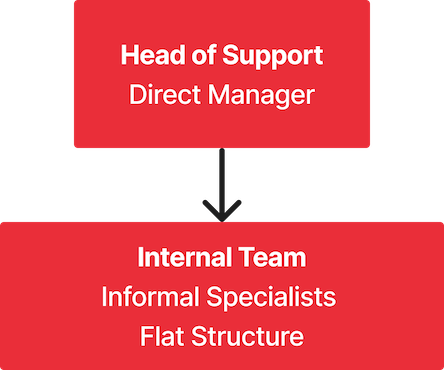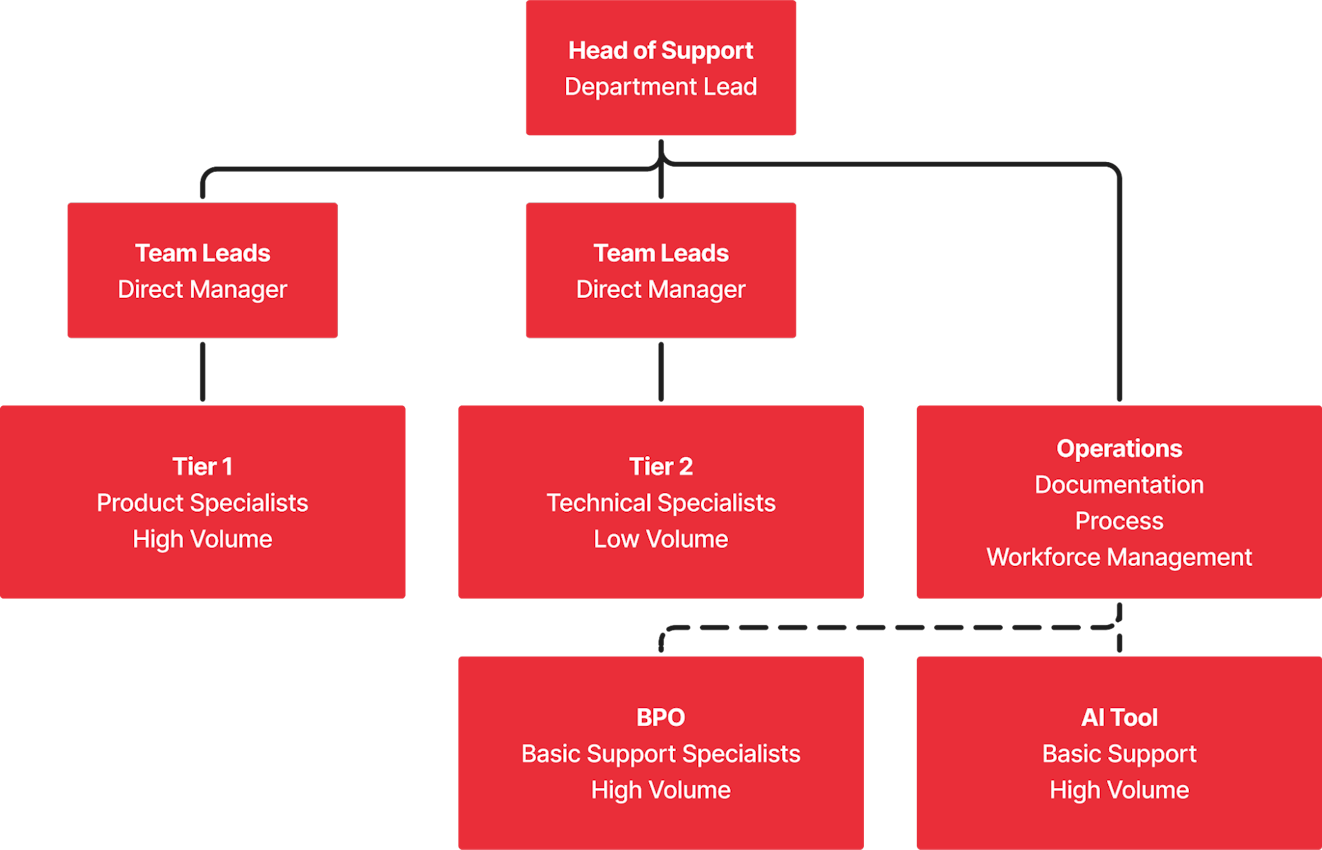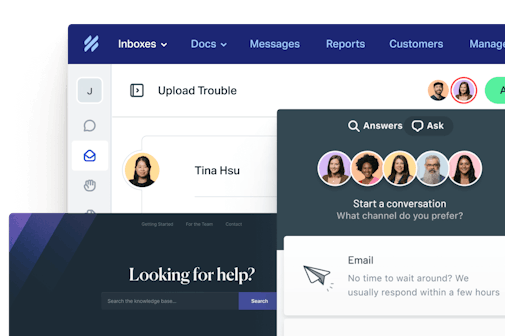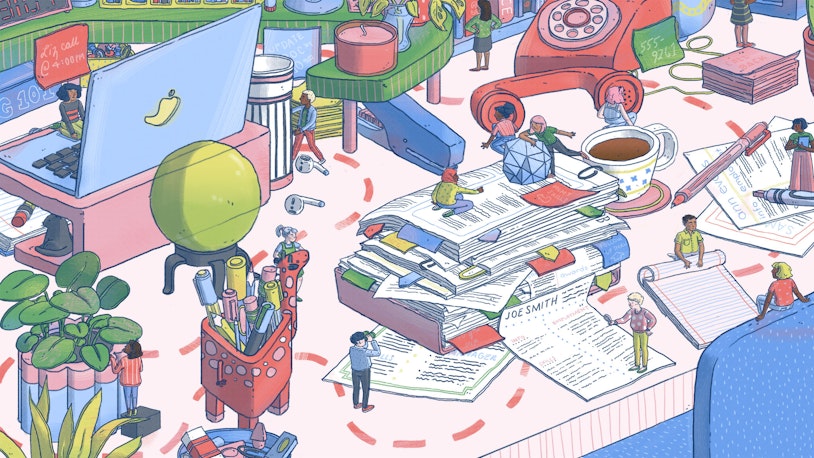Building a high-performing SaaS support team is one of the most critical — and challenging — investments early-stage companies make.
Get it wrong, and you'll struggle with churn, poor customer relationships, and a team that can't scale with your growth.
Get it right, and your support team can be your biggest competitive advantage. The difference comes down to hiring the right people, building the right processes, and scaling thoughtfully as you grow.
What is SaaS customer support?
SaaS customer support is the assistance provided to users of software-as-a-service (SaaS) products. It typically includes channels like email, chat, phone, and self-service resources.
Like all types of support, it includes fixing immediate problems. But what’s unique about SaaS is that it also means helping users continuously find value from products that are constantly evolving. This is because SaaS products are subscription-based, so customer success directly affects retention, adoption, and recurring revenue.
That means SaaS support organizations require a different strategy than those in other industries — an approach that emphasizes long-term relationships over transactional experiences, focusing on connections that help you understand your customers' needs and drive improvements to your product.
Why great customer support is critical for SaaS companies
Great customer support is crucial for SaaS companies as it serves as both a revenue engine and a key product feature. Rather than being a “necessary evil,” SaaS support has wide-reaching business impacts.
Here’s what that means in practice:
Support helps reduce churn and keep acquisition costs down. SaaS companies typically spend a significant amount of money acquiring each customer through marketing and sales efforts. When customers leave due to preventable issues, that entire acquisition investment is lost.
Support drives retention in the subscription economy. Unlike one-time purchases, SaaS revenue depends on customers choosing to renew repeatedly. Research by Ventrica shows that fast, empathetic support fosters stronger brand loyalty, while poor experiences directly drive churn and erode recurring revenue.
Support teams generate product intelligence. As the group that interacts with customers more than any other, support teams gather critical insights about user needs, pain points, and feature requests. Close collaboration with product teams helps translate these trends into actionable improvements, creating a feedback loop that improves the product and reduces future support volume.
Support influences buying decisions. The Martal Group reports that 81% of buyers consider a differentiated customer experience a deciding factor in vendor selection. In competitive SaaS markets, a reputation for excellent support becomes a powerful acquisition tool that reduces marketing costs and accelerates sales cycles. It helps brands stand out from their competition.
Support enables expansion revenue. Support interactions also reveal opportunities for customers to upgrade plans, add users, or adopt underutilized features. Well-trained support teams can guide customers toward greater product adoption, directly driving account growth beyond the base subscription.
The subscription model transforms customer relationships from transactional to ongoing partnerships, making great support both a protective measure for recurring revenue and a growth driver that impacts every stage of the customer lifecycle.
The building blocks of a great SaaS customer support strategy
There are many ingredients to great customer service, but certain elements are essential to creating a scalable and effective customer service organization.
Maintaining customer centricity
The customer is at the core of great customer support, but it's common for companies to lose focus in the face of competing priorities. The best support teams (and companies) make concerted efforts to continue to center on their customers. It's like strengthening a muscle that requires consistent attention.
Starting out with the right mindset and rituals early can help make this stick with your team. Effective rituals include:
Regular negative interaction reviews. Identify ways in which you're failing to serve your customers, and work out the best way to resolve them.
Root cause analysis. Look beyond individual tickets to spot patterns that indicate deeper product or process issues.
Tracking customer outcomes. Follow up on resolutions to ensure they actually solved the customer's broader goals.
These reviews should use a wide “lens” to root out deeper issues in your product or experience. Finding these opportunities to help customers should never stop. Great teams focus on asking deeper and deeper questions, such as:
What is this customer really trying to accomplish?
After this issue is resolved, what’s the next thing they’ll need?
Can we be proactive to help them with that?
As teams grow, their focus can often shift from helping customers broadly to a more narrow view of solving the ticket at hand. While assisting each customer individually is important, this drift can often lead to companies losing sight of the bigger opportunities to help customers as a whole.
Ensure your team acknowledges and rewards behaviors that identify and resolve broader problems — such as providing high-quality product feedback that prevents issues before they arise — loudly within your team.
Setting personalization as the bare minimum
Generic support feels disposable, like the customer is just another ticket in the queue.
Personalization makes your support feel intentional, human, and valuable — it signals that you see the person behind the problem.
Nowadays, customers are bombarded with low-quality AI responses. That means thoughtful human interactions stand out as even more unique and impactful. Customers are the first to feel it when our efforts fall short.
A whopping 76% of customers report being frustrated when they don't receive personalized support, indicating that personalization is a solid expectation for businesses.
Set your team up for success by configuring your help desk software to store CRM data, account details, and product usage history that make it easy for support agents to tailor their responses. Use this information to avoid making customers repeat the things you should already know.
Enshrine in your team's communication handbook best practices that acknowledge individuals and build trust and loyalty.
Use preferred names and personal details. Greet customers by their chosen names and reference relevant account information.
Acknowledge customer expertise. Avoid sending basic troubleshooting steps to skilled customers who you know have likely tried them.
Reference interaction history. Build on previous conversations rather than starting from scratch each time.
Aim for unique interactions. Responses are truly personalized when they wouldn’t make sense if you sent them to a different customer. While that can be difficult to achieve at times, it’s a good barometer you can use to gauge if you’re appropriately personalizing interactions.
Offering proactive support
Building on strong personalization practices, the next level is anticipating customer needs before they arise.
At a high level, reactive support is when you wait for the customer to reach out with a problem — those are the tickets your team works on daily. Proactive customer support involves activities that resolve customer problems before they need to contact you.
Why does proactive support matter?
Proactive support is more efficient than reactive support, because it eliminates the need for customers to contact you. It’s key to scaling your team, and it’s essential because it reduces friction for your customers.
Proactive support can take many forms depending on your product and customer needs:
Preemptive issue notifications: Alert users about known problems before they encounter them, like upcoming service maintenance or feature changes.
Payment and billing alerts: Send messages to users with upcoming charges but expired credit cards, preventing failed transactions and frustrated customers.
Educational content delivery: Offer webinars, guided onboardings, or help articles that address frequent customer challenges.
Usage-triggered guidance: Proactively reach out when customer behavior suggests they might need help or could benefit from additional features.
While it takes a little time upfront to set up systems and processes to proactively solve these issues, they’re well worth it for the impact they have over the long run.
Assembling the perfect SaaS customer support toolkit
While great customer support starts with great humans, those humans need the right tools to be successful.
Tools can be powerful enablers for building delightful experiences for your customers. With so many options out there, it can be overwhelming to even get started.
To make things easier, here are the critical customer service tools to make sure you’re in good shape.
An approachable, searchable knowledge base
Start with self-service — it's your first line of defense and many customers' preferred starting point.
Even back in 2017 (which feels like a long time ago in SaaS!), 81% of customers reported trying to solve problems themselves before reaching out for help, providing you the opportunity to prevent a ticket from being created.
A well-organized knowledge base reduces inbound volume and empowers users to find solutions on their own. When choosing knowledge base software for your SaaS company, look for tools that offer clear navigation and fast search capabilities. Fill your knowledge base with content that is short, scannable, and focused on solving specific problems.

Your help center should integrate seamlessly with your support workflow by:
Prioritizing tools that make it easy for your team to reference documentation while supporting customers.
Providing clear analytics on how customers use your articles. Good reporting reveals which articles are helpful and which aren't (such as those that customers read and then still require assistance).

Quality self-service content also becomes valuable training material if you choose to implement AI support tools later.
Multi-channel help desk
Your help desk is the foundation of your customer service toolkit, and choosing the right one is often the first decision a small team faces. While many support teams start with one channel, as you scale your team and grow your customer base, it’s important to be able to handle multiple channels well, whether that's phone, chat, email, or social media.
Customers expect you to be available in the format that feels most natural for them, and companies that deliver see significant benefits.
As omnichannel support becomes table stakes, the focus shifts to experience quality. Good support shouldn't feel fragmented — customers who start with email, switch to chat, then follow up on social media expect continuity throughout their journey.
A unified help desk keeps all conversations in one view, avoids duplication, and helps teams work faster. Look for platforms that maintain conversation history across channels and provide your team with full context regardless of how customers reach out.
AI and automation
AI can save time, but misuse it, and it becomes a barrier between you and your customers.
The key is viewing AI as an enhancer of your team rather than a replacement, giving your human agents superpowers to help more customers more effectively.
While customer service chatbots often get the most attention, AI can be hugely valuable in behind-the-scenes improvements. Consider AI features that automatically prioritize urgent tickets, identify subtle trends in incoming volume, or draft initial reply suggestions for your team to review and personalize.
Before choosing any AI tool, develop a clear idea of why you’re implementing it and how you’ll use it:
Know what goals you have for AI implementation, how you'll measure success, and what resources you can invest. A poorly implemented AI solution creates more problems than it solves, regardless of how advanced the technology appears.
The most effective AI tools emerge from thoughtful human curation, beginning with a foundational customer experience and building intelligent automation on top of robust support processes.

SaaS customer support metrics that matter
What you measure matters, but you can't understand your customer experience through metrics alone.
As Jerry Muller notes in The Tyranny of Metrics, “Those who believe that what you cannot quantify does not exist also believe that what you can quantify, does.”
Metrics are like shadows — they outline the shape of your customer experience, but often without revealing the details. When your numbers look good but customers seem frustrated or when metrics dip but feedback stays positive, you're seeing the difference between the shadow and the real thing.
This doesn't mean you shouldn't measure anything. Try explaining to your CEO that you're not tracking first response time because metrics don't capture the essence of the customer experience, and it probably won’t go over well.
Instead, it means being intentional about what you measure, avoiding customer service metrics that don't reflect what they claim to, and balancing quantifiable data with qualitative insights.
The metrics basket approach
As you grow and become removed from day-to-day support, it becomes easier to misuse metrics and incentivize wrong behaviors.
In one role, I noticed our highest satisfaction scores came from tickets where we issued refunds, but that didn't mean we should encourage unnecessary refunds to boost CSAT. Focusing too narrowly creates tunnel vision that moves numbers without improving actual customer outcomes.
Instead, use a "basket" of diverse metrics representing different aspects of your team's impact and customer experience.
Customer experience metrics worth tracking
Below are metrics used by leaders of high-performing, high-empathy SaaS companies to help you build your own measurement framework.
Customer Effort Score (CES)
What it measures: Customer Effort Score is designed to measure how much effort it took for a customer to get something done — like solving a problem or finding an answer.
Why it matters: A study conducted by Gartner found that customer effort predicts loyalty 40% more accurately than customer satisfaction.
For a SaaS company where retention is key, CES is a metric that makes a lot of sense. CES survey results are more action-oriented and specific. They highlight friction in the user experience (e.g., confusing processes, bad UI), making it easier to improve. This is opposed to customer satisfaction’s (CSAT's) focus on customer sentiment, which is often vague and subjective.
Contact rate
What it measures: The percentage of active users who contact support over a given period. The formula is: (number of new support requests ÷ number of active users) × 100 for the same time period.
Why it matters: Your contact rate is a metric that speaks to the ease of use of your product. This is one of the best ways to make sure your support team is thinking proactively and working to improve the overall customer experience. As your customer base grows, you need to find ways to keep contact rate low or you’ll be overwhelmed with tickets (or spend a ton of money on hiring more and more agents)
It’s also a key way to quantify the impact of your team's product feedback and other proactive support efforts, which should reduce the need for your customers to ask for help.
Self-service metrics
AI deflection rate
What it measures: The percentage of conversations your AI handles without requiring human intervention.
Why it matters: SaaS support typically means a small team helping a large customer base. Efficiency is critical, and your success with tools like AI is one of the most essential ways to scale successfully.
While AI can't — and shouldn't — solve all of your customers’ issues, a well-designed system can often help deflect 20%-50% of your incoming volume, enabling your human team to focus on the issues that most require their expertise.
Help center deflection rate
What it measures: How often customers find solutions in your knowledge base without creating tickets.
Why it matters: Your help center is a vital tool for scalability. A thoughtful and up-to-date knowledge base can have an equal impact in ticket deflection as an AI (and trains your AI, too!). Modern knowledge base tools like Help Scout's Docs will offer a convenient way to track the conversations created (or not) after viewing your documentation.
This helps you understand which articles are working and providing your customers with the information they need to self-serve and which articles aren't performing.
Responsiveness metrics
First response time (FRT)
What it measures: FRT is a measure of how much time passes between a customer's initial outreach to your team and the first human response they receive. Typically, customers have different expectations based on the channel used. In my experience, some common benchmarks by channel are:
Phone: 2 minutes.
Chat: 10 minutes.
Email: 10 hours.
Why it matters: When customers need help, they want it fast. The right target varies from industry to industry, but these numbers provide broad guidance for you to consider when tracking your own success.
Time to resolution (TTR)
What it measures: Time to resolution measures the duration of customer requests before they are resolved.
Why it matters: Getting a fast response to customers goes a long way, but solving their problems is just as important. In fact, 60% of respondents highlighted “issue resolution” as an important aspect of good customer service (the top category!).
TTR is how we understand one dimension of the resolution experienced by tracking how long a customer request is open before it is finally resolved for good. Customer effort score (CES) can help track how easy it was to get that resolution. Slow resolutions can indicate a poor experience for customers, so keeping an eye on this metric is critical.
Building a high-performing SaaS support team
Building a high-impact SaaS support team isn't an easy task. I've helped build several teams for early-stage startups, and I’ve established an approach informed by those experiences that makes the process more manageable.
While each company's needs vary, this guidance provides a solid starting point that should be adjusted to reflect your business's unique reality.
Hiring for customer support
Early-stage SaaS support teams function differently from teams at larger or more established companies. Smaller companies with fewer resources and newer products that iterate quickly present unique challenges that require specific skills.
Hiring a team accustomed to highly regimented support roles at large tech companies and dropping them into a poorly documented, quickly changing startup environment is a recipe for disaster.
When building your team from stage 0 to stage 1 (see below), hire people with direct early-stage experience. Among those hires, look for a mix of skills and experiences — at small team sizes, a diversity of capabilities has exponentially higher value.
Look for generalists, not specialists
Your first few support hires will wear many hats. Yes, they’ll help customers, but they'll also write documentation, help configure tools, and develop processes. Often they'll be directly involved in cross-functional work. A new hire with broad skills can be more impactful than one who specializes in a single area.
As your team grows, these teammates might naturally specialize into unique roles, but initially you can't afford narrow skill sets.
Avoid hires that view support as a foot in the door
Many people look for startup opportunities, and eager job seekers sometimes view support roles as "entry level" ways into companies that are not hiring for their primary skill set.
A common mistake is building a team lacking the necessary support expertise at this early stage.
Think of these early hires as the foundation on which your support experience will be built. You want a strong foundation staffed with teammates who understand what it takes to scale from here.
Hire people who are naturally curious
People who love puzzles are usually well-suited for the high-complexity issues most common at early-stage SaaS companies.
A curious desire to understand systems drives solving problems, not just tickets. They can blaze trails when new features launch with lacking documentation or find underlying connections in seemingly unrelated problems.
While this trait can be difficult to identify, it's worth the effort to look for during your hiring process.
Customer support roles and growth
As a SaaS company grows, so does the complexity of its support needs.
What starts as a handful of generalists quickly evolves into a layered team with specialized roles, clearer ownership, and paths for growth. This section outlines how support teams typically scale, from reactive, founder-led efforts to structured, strategic operations.
This isn't a perfect timeline, and teams have varying needs, but it provides guidance as you grow.
Founder-led efforts (stage 0)
Team size: Just you
Typical timeline: Pre-product-market fit
Most SaaS products start with a founder handling support. If you're a founder looking for guidance on transitioning this responsibility to a dedicated team, know that these efforts don't scale — and that's OK. You can't keep doing the same things and reach the next level.
The flat team (stage 1)
Team size: 1-3 people
Typical timeline: Early product-market fit, hundreds of customers
This begins when you hire your first full-time support staff.
These early teammates are critical to long-term success and need broad latitude to solve problems, typically working directly with product and engineering teams. Each teammate contributes to work outside the queue, like drafting documentation and developing processes.
The team members operate as equals, sharing responsibility for both customer-facing work and operational tasks like process development and tool configuration.

Player-coach leadership (stage 2)
Team size: 3-6 people
Typical timeline: Growing customer base, scaling challenges emerge
The need for management becomes apparent around 3-5 team members. This manager enables and empowers the frontline to provide the best possible help and advocate for customers.
These early leaders are typically player-coaches who move easily between leadership and customer-facing tasks.
The team still shares non-queue responsibilities, though people might gravitate toward their special interests and skills. This is often when you see the first informal specializations emerge — someone becomes the "documentation person" or the "tool configuration expert."
Specialization and structure (stage 3+)
Team size: 6+ people
Typical timeline: Established product, complex customer needs
The next leap can sneak up on a team.
One day you might notice that the list of documents needing updates in your help center only gets longer, its structure having become sloppy as the team rushes to make changes. You'll feel the need for your first specialist — typically a customer support operations role.
Common specialized teams that emerge include:
Support operations: This person oversees documentation, training, processes, and tooling. It’s usually the first specialized role as the operational burden becomes too much for the frontline team to handle alongside customer work.
Technical support: This includes team members with skills and a mandate to dive deeply into complex customer issues. They unblock your frontline team from the snags that tricky tickets can cause and save your engineers from all but the most complex issues.
Customer success: These folks focus on proactive outreach, onboarding, and expansion rather than reactive support. This role bridges support and sales as customer relationships become more strategic.
Each specialized team typically needs its own lead as responsibilities and expertise requirements diverge from general support work.

Putting it all together
Great support isn't reactive, and it's certainly not accidental. It's strategic, proactive, deeply human, and essential to scaling a SaaS business that customers want to stick with.
The companies that get this right understand that support is both a cost center and a growth engine. They invest in the right people: curious generalists who can scale with the business. They choose tools that enhance rather than replace human connection. They measure what matters while recognizing that the most important aspects of customer relationships can't always be quantified.
Most importantly, they're willing to break a few rules in service of doing what's right for the customer, whether that's empowering agents to make exceptions, prioritizing customer outcomes over process efficiency, or viewing support conversations as opportunities to strengthen relationships rather than just resolve tickets.
Invest in your team, your tools, and your systems. Build a strong foundation from day one, and don't be afraid to evolve as you grow. Your customers — and your business — will thank you for it.









